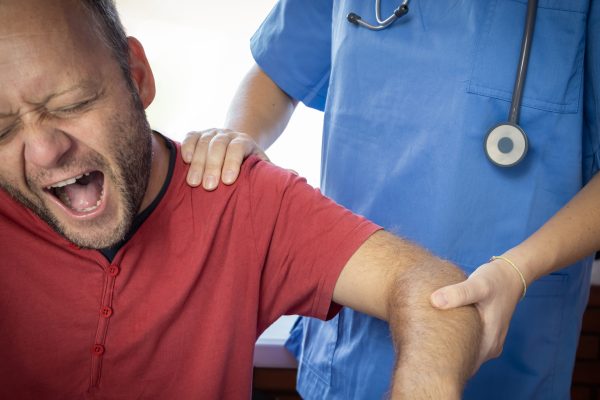Dislocation

Dislocation injuries are common occurrences in sports medicine and can have significant implications for athletes. Dislocation refers to the displacement of bones from their normal positions within a joint, often resulting from traumatic events or extreme force.
Understanding the significance of dislocation injuries, recognizing their causes and symptoms, and implementing appropriate treatment strategies are crucial for athletes and sports medicine professionals.
This article aims to shed light on the importance of addressing dislocation injuries in sports medicine and provide insights into their causes, symptoms, and treatment options.
The Significance of Dislocation Injuries in Sports Medicine
Dislocation injuries are significant in sports medicine for several reasons:
Functional Impairment
Dislocations can cause severe pain, loss of function, and immediate functional impairment in the affected joint. This can significantly impact an athlete’s performance, limit their ability to participate in sports activities, and hinder overall athletic development.
Associated Injuries
Dislocation injuries can often lead to other associated injuries, such as ligament sprains, muscle strains, fractures, or nerve damage. Proper evaluation and management of dislocations are crucial to address these accompanying injuries and prevent further complications.
Recurrence Risk
Athletes who have experienced a dislocation are at an increased risk of recurrent dislocations in the same joint. Proper treatment and rehabilitation are essential to reduce the likelihood of future dislocations and provide long-term joint stability.
Causes of Dislocation Injuries
Dislocations in sports medicine can occur due to various factors, including:
Trauma or Impact
Direct blows, falls, collisions, or high-velocity forces can result in dislocation injuries. Contact sports, such as football, rugby, or basketball, carry a higher risk of traumatic dislocations.
Excessive Force or Overextension
Abrupt and forceful movements that cause the joint to extend beyond its normal range of motion, such as hyperextension or excessive twisting, can lead to dislocations.
Joint Instability
Athletes with inherent joint laxity or previous injuries to ligaments and surrounding structures are more susceptible to dislocations.
Symptoms of Dislocation Injuries
Dislocation injuries are characterized by the following symptoms:
Severe Pain
Dislocations typically cause intense and immediate pain at the site of the injury. The pain may be worsened with movement or weight-bearing.
Visible Deformity
Dislocations often result in an obvious deformity or misalignment of the joint. The affected limb may appear disfigured, twisted, or out of place.
Swelling and Bruising
Rapid swelling and bruising around the joint are common after dislocation injuries due to soft tissue damage and bleeding.
Limited Range of Motion
Dislocations often restrict the normal range of motion of the affected joint. Athletes may experience difficulty moving the joint or performing certain actions.
Treatment of Dislocation Injuries
The treatment approach for dislocation injuries involves immediate and proper management to ensure optimal recovery. Treatment options may include:
Reduction
Dislocated joints need to be promptly and properly reduced, which involves realigning the bones back into their normal positions. This procedure should be performed by a qualified healthcare professional to avoid further damage.
Immobilization
After reduction, the joint is typically immobilized using a splint, brace, or cast to protect the area, allow for healing, and prevent recurrent dislocation.
Rehabilitation and Physical Therapy
Once the immobilization period is over, a structured rehabilitation program and physical therapy are crucial for restoring joint mobility, strength, and stability. These exercises aim to improve muscle strength, flexibility, and proprioception, reducing the risk of future dislocations.
Medications
Nonsteroidal anti-inflammatory drugs (NSAIDs) or analgesics may be prescribed to manage pain, reduce inflammation, and facilitate rehabilitation.
Surgical Intervention
In some cases, particularly for severe dislocations or associated injuries, surgical intervention may be required. Surgery aims to repair damaged ligaments, tendons, or other structures and restore joint stability.
Prevention of Dislocation Injuries
Preventing dislocation injuries in sports can be challenging, but the following measures can help reduce the risk:
Proper Training and Technique
Athletes should receive appropriate training, coaching, and instruction to ensure proper technique, body mechanics, and safe play.
Strengthening and Conditioning
Regular strength and conditioning exercises targeting the muscles surrounding the joints can enhance stability and reduce the risk of dislocations.
Protective Gear
Wearing appropriate protective gear, such as helmets, braces, or padding, can provide additional joint support and minimize the impact of traumatic forces.
Injury Prevention Programs
Incorporating injury prevention programs into training routines can help athletes develop adequate strength, flexibility, and neuromuscular control, reducing the risk of dislocations.
Conclusion
Dislocation injuries are significant in sports medicine due to their potential impact on an athlete’s performance, function, and long-term joint stability. Prompt and appropriate management is crucial to minimize pain, prevent recurrent dislocations, and address associated injuries.
Athletes should seek immediate medical attention, follow recommended treatment protocols, and engage in rehabilitation programs to optimize recovery and safely return to sports activities.
Emphasizing injury prevention, proper training, and protective measures can play a vital role in reducing the occurrence of dislocation injuries in sports.
